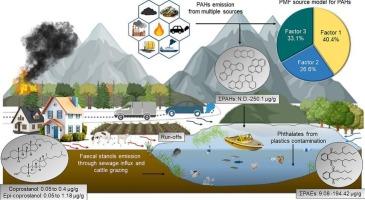西北喜马拉雅地区淡水湖系统新发有机污染物的发生、来源及控制因素
Q1 Environmental Science
Environmental Nanotechnology, Monitoring and Management
Pub Date : 2025-09-14
DOI:10.1016/j.enmm.2025.101099
引用次数: 0
摘要
研究了喜马拉雅西北部马纳斯巴尔湖表层沉积物中邻苯二甲酸酯(PAEs)、多环芳烃(PAHs)和粪便甾醇的赋存状态、来源和空间分布。Σ4PAEs的浓度范围为9.08 ~ 194.42 μg/g, Σ16PAHs的浓度范围为不可检测(未检出)~ 250.1 μg/g。检测粪蛋白酶醇和外皮粪蛋白酶醇等污水标志物,其浓度范围分别为0.05 ~ 0.4µg/g(平均为0.17µg/g)和0.05 ~ 1.18µg/g(平均为0.26µg/g),表明粪便污染严重。检测到的PAEs包括邻苯二甲酸二乙酯、邻苯二甲酸二异丁酯、邻苯二甲酸二丁酯异构体和邻苯二甲酸二(2-乙基己基)酯。沉积物中PAEs的主要来源是附近村庄的生活垃圾、居民区的垃圾处理和建成区。采用正矩阵分解法的三因素模型发现,燃料燃烧是多环芳烃最主要的污染源,占40.4%,其次是生物质燃烧,约占33.1%。Σ16PAEs、Σ4PAEs和甾醇类化合物的最高浓度出现在靠近入口的东部地区,表明它们的分布受靠近污染源的强烈影响。相反,这些有机污染物与沉积物特征(粒度和TOC含量)或水深之间没有显著关系。Σ4PAEs与微塑料丰度的显著相关表明PAEs可以作为识别沉积物中塑料污染的有效标志物。本研究增强了喜马拉雅淡水系统中新出现污染物的基线特征,有助于更好地了解其在全球水生系统中的潜在来源和分布控制。本文章由计算机程序翻译,如有差异,请以英文原文为准。

Occurrence, sources, and controlling factors of emerging organic pollutants in a freshwater lake system in the NW Himalayas
The occurrence, sources, and spatial distribution of phthalate esters (PAEs), polycyclic aromatic hydrocarbons (PAHs), and faecal stanols were simultaneously investigated in surface sediments from Manasbal Lake, NW Himalayas. The concentrations of Σ4PAEs ranged from 9.08 μg/g to 194.42 μg/g, while Σ16PAHs varied from non-detectable (n.d.) to 250.1 μg/g. Sewage markers such as coprostanol and epi-coprostanol were detected, with concentrations ranging from 0.05 to 0.4 µg/g (mean = 0.17 µg/g) and 0.05 to 1.18 µg/g (mean = 0.26 µg/g), respectively, indicating significant faecal pollution. Detected PAEs included diethyl phthalate, di-isobutyl phthalate, dibutyl phthalate isomers, and di(2-ethylhexyl) phthalate. The primary sources of PAEs in the sediments were domestic waste from nearby villages, garbage disposal from residential areas, and built-up regions. Three-factor modeling using positive matrix factorization identified fuel combustion as the most significant source of PAHs, contributing 40.4 % of the pollution, followed by biomass combustion, which accounted for approximately 33.1 %. The highest concentrations of Σ16PAEs, Σ4PAEs, and stanols compounds were observed in the eastern part near the inlet, suggesting that their distribution is strongly influenced by proximity to pollution sources. Conversely, there was no significant relationship between these organic contaminants and sediment characteristics (grain size and TOC content) or water depth. The significant correlation between Σ4PAEs and microplastic abundance indicates that PAEs can serve as effective markers for identifying plastic pollution in sediments. This study enhances the baseline characterization of emerging contaminants in Himalayan freshwater systems and contributes to a better understanding of the potential sources and controls on their distribution in aquatic systems globally.
求助全文
通过发布文献求助,成功后即可免费获取论文全文。
去求助
来源期刊

Environmental Nanotechnology, Monitoring and Management
Environmental Science-Water Science and Technology
CiteScore
13.00
自引率
0.00%
发文量
132
审稿时长
48 days
期刊介绍:
Environmental Nanotechnology, Monitoring and Management is a journal devoted to the publication of peer reviewed original research on environmental nanotechnologies, monitoring studies and management for water, soil , waste and human health samples. Critical review articles, short communications and scientific policy briefs are also welcome. The journal will include all environmental matrices except air. Nanomaterials were suggested as efficient cost-effective and environmental friendly alternative to existing treatment materials, from the standpoints of both resource conservation and environmental remediation. The journal aims to receive papers in the field of nanotechnology covering; Developments of new nanosorbents for: •Groundwater, drinking water and wastewater treatment •Remediation of contaminated sites •Assessment of novel nanotechnologies including sustainability and life cycle implications Monitoring and Management papers should cover the fields of: •Novel analytical methods applied to environmental and health samples •Fate and transport of pollutants in the environment •Case studies covering environmental monitoring and public health •Water and soil prevention and legislation •Industrial and hazardous waste- legislation, characterisation, management practices, minimization, treatment and disposal •Environmental management and remediation
 求助内容:
求助内容: 应助结果提醒方式:
应助结果提醒方式:


